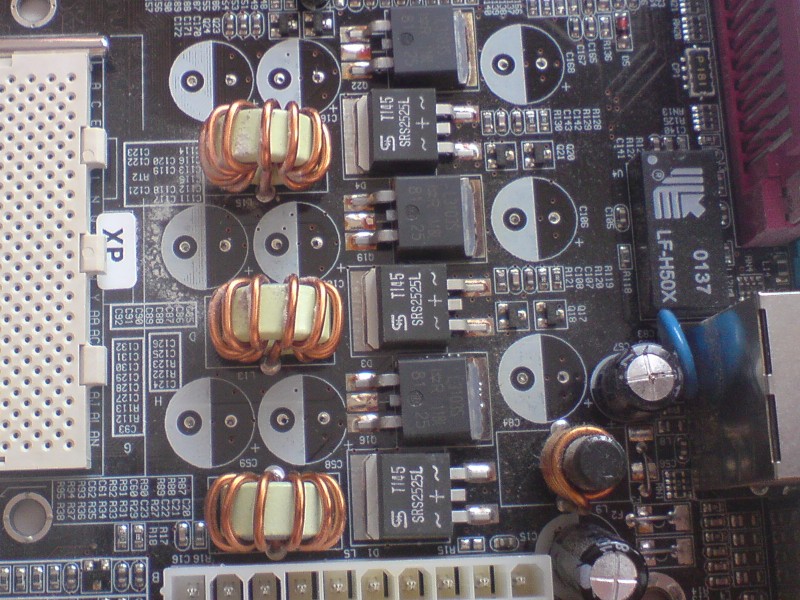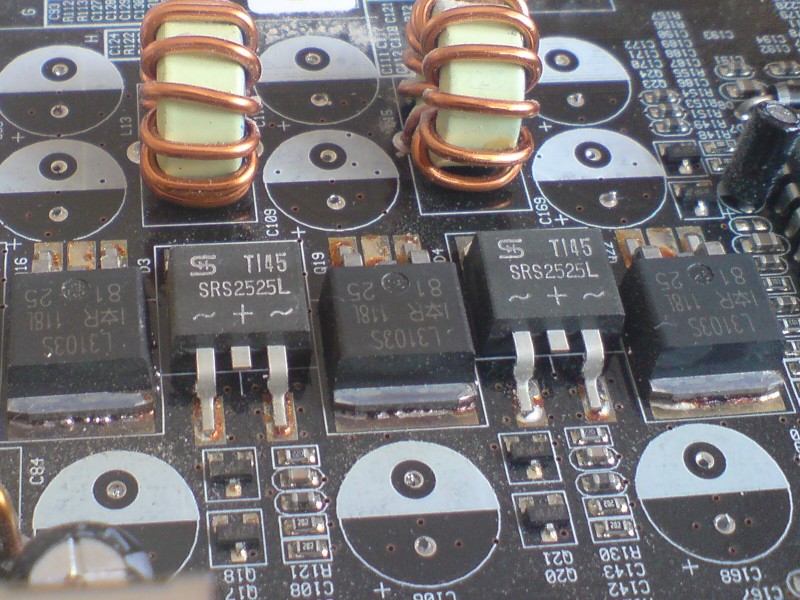I was about to recap some swollen G-LUXON caps on this mobo when I noticed some discoloration by the MOSFETs. I'm worried that they might be fried but I don't know how to test them.


ECS K7S5A mosfet issue
Collapse
X
-
Re: ECS K7S5A mosfet issue
I'm not an expert, but that could be leftover flux residue from the factory soldering process on those chips?--- begin sig file ---
If you are new to this forum, we can help a lot more if you please post clear focused pictures (max resolution 2000x2000 and 2MB) of your boards using the manage attachments button so they are hosted here. Information and picture clarity compositions should look like this post.
We respectfully ask that you make some time and effort to read some of the guides available for basic troubleshooting. After you have read through them, then ask clarification questions or report your findings.
Please do not post inline and offsite as they slow down the loading of pages.
--- end sig file --- -
-
Re: ECS K7S5A mosfet issue
In any case when the caps fail (like yours have) the Mosfets have to work much harder.
So they become allot hotter (there are even examples on this site where the Mosfets have desoldered themselves)
So either they have become really hot or it's just leftover flux residue from the factory, in any case with new caps the board should work fine"The one who says it cannot be done should never interrupt the one who is doing it."Comment
-
Re: ECS K7S5A mosfet issue
Since the consensus is that it is flux residue, you may want to clean that off using alcohol. I believe flux, over time, will eat away at the board (I think I read that somewhere). A q-tip and isopropyl should do the job.
Originally posted by DammonThanks, guys. I'm going to go ahead and install the new caps. I'll post some pics later when I get it to work.--- begin sig file ---
If you are new to this forum, we can help a lot more if you please post clear focused pictures (max resolution 2000x2000 and 2MB) of your boards using the manage attachments button so they are hosted here. Information and picture clarity compositions should look like this post.
We respectfully ask that you make some time and effort to read some of the guides available for basic troubleshooting. After you have read through them, then ask clarification questions or report your findings.
Please do not post inline and offsite as they slow down the loading of pages.
--- end sig file ---Comment
-
Re: ECS K7S5A mosfet issue
Test them with the diode function on your multimeter.
I re-capped an Intel board with failed Rubycons (2004 date range) - one of the mosfets shows a dead short in circuit (all show dark flux residue on the mosfets like yours), board won't power up, I may try and find a replacement, but I ended up substituting another socket 478 board.Comment
-
Re: ECS K7S5A mosfet issue
Clean up any of the "solder balls" such as those around Q16. Those balls sure make it appear that it overheated, but hopefully they weren't destroyed.
DigiKey has these, but you'll need to cut & bend the leads (L package vs. S package):
http://search.digikey.com/scripts/Dk...IRL3103LPBF-ND
Datasheet:
https://cdn.badcaps-static.com/pdfs/...556264df4f.pdf
Toastveritas odium paritComment
-
Re: ECS K7S5A mosfet issue
most of the time when i see surface mount mosfets with bubbly solder and blue-ish discolored (and sort-of dull) metal parts those are dead shorted from overheating.
check them with the diode test on your multimeter as seanc said.
ohm/beep test may also work to find shorted ones.
*carefully* lifting the 2 pins up from the pads prevents false readings from somewhere else in the circuit.
if one of them is in fact shorted, replace all of them at once. i did that a couple times salvaging similar spec'd mosfets from otherwise damaged and unfixable boards.
just don't mix up different types (ex.: 4x identical mosfet replaced with 2x mosfet ABC and 2x mosfet XYZ)
worst case scenario.. (was still fixable though)
Last edited by Scenic; 06-25-2010, 02:22 PM.
Comment
-
Re: ECS K7S5A mosfet issue
Sorry for the late update, I had to wait for more caps to be shipped.
I didn't replace all the crap caps, just the ones that had swollen tops. Didn't see the point in recapping the whole board with good caps since it would only see infrequent use. There were 11 swollen caps: 9x 2200uf 6.3v, 1x 1000uf 10v, and 1x 470uf 16v.
Was a little worried when I powered it on because the soldering iron slipped once or twice on the motherboard.
Fortunately, it still works.
Ran through memtest and Prime95 for a couple hours with no problem. Prior to recapping, the board would hang in less than 10 seconds.
It's quite a thrill to see a board that I had written off as dead many years ago come back to life.
Comment
Related Topics
Collapse
-
by CuboyHello,
I am currently trying to help a ONG by volunteering to help repair laptops, it's something that i have been into since 2017, always watching videos, on discords, forums etc...
I have an HP ProBook 4510s laptop that does not power on and has no indicator lights, which suggests an issue with the power supply or the motherboard.
I started by verifying that there is voltage at the input of the motherboard, confirming that the power adapter is working correctly. However, when I checked the voltage at the output of the first MOSFET (Q1032), I found 19V at... -
by ebyte64Good day everyone.
I have been scratching my head with a Lenovo laptop I got in today.
The laptop had no power and taking no amps from the power supply. Checking voltage showed 20v only on one side of the first mosfet. Took it off and replaced it and then same story. Took off second mosfet and then the first mosfet had the right voltages as well as 25v on gate is it should. Replacing the second mosfet the problem started again.
Even using a wire to bypass the second mosfet does the same interference with the first mosfet.
Would anyone... -
by JaneI tried to use this method:
Testing an N-channel MOSFET:
Step 1: Discharge the Gate (turn off the MOSFET)
Place the black probe (COM) on the Source (S) and the red probe on the Drain (D). The multimeter should show no continuity (high resistance or "OL" – open line).
Then, touch the black probe to the Source (S) and the red probe to the Gate (G). This discharges any stored charge in the Gate, turning the MOSFET off.
Step 2: Charge the Gate (turn on the MOSFET)
Now, place the red probe on the Gate (G) and the black probe on the...09-27-2024, 03:31 AM -
by NooyHello everyone, I recently found this badcaps site and super Learn Electronics Repair youtube channel. And I wanted to learn how to troubleshoot power supplies and VGA cards and how to practice soldering, since I already have a properly defective piece of them. I am currently trying to solve two problems:
I have a Gigabyte GV-RX460WF2OC-4GD type card. I managed to find the faulty MOSfet (AON6414A) on it, which I replaced. The card starts up, but after about half a minute, the MOSfet in the same position will be shorted again. Is it possible that the PWM controller driving the MOSfet... -
by redbaron1007I have a Razer laptop (RZ09 MB# CH570_MB_NT) that has a shorted mosfet marked BND M03 E067 that I'm unable to find anywhere online. Does anyone either know what the part number is for this mosfet or have a schematic I can find it in?
Backstory on the whole thing the laptop was plugged into a lamp at a hotel. The lamp got unplugged while it was charging and now the system won't power on anymore. I found the caps around this mosfet shorted and when I injected voltage into the caps the mosfet got hot and my bench psu was pulling 5A. Pretty sure this is all that's wrong with the laptop...1 Photo - Loading...
- No more items.

Comment